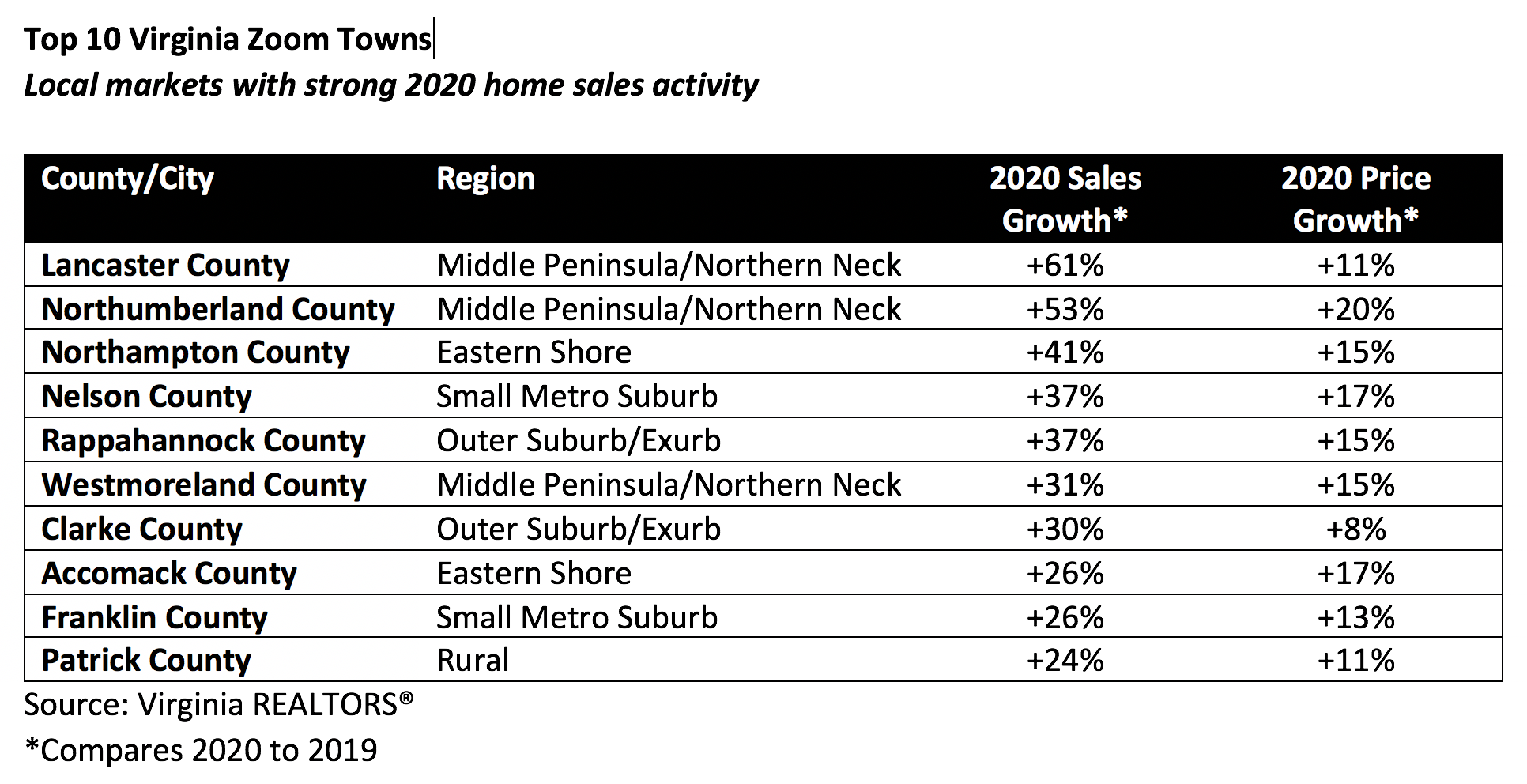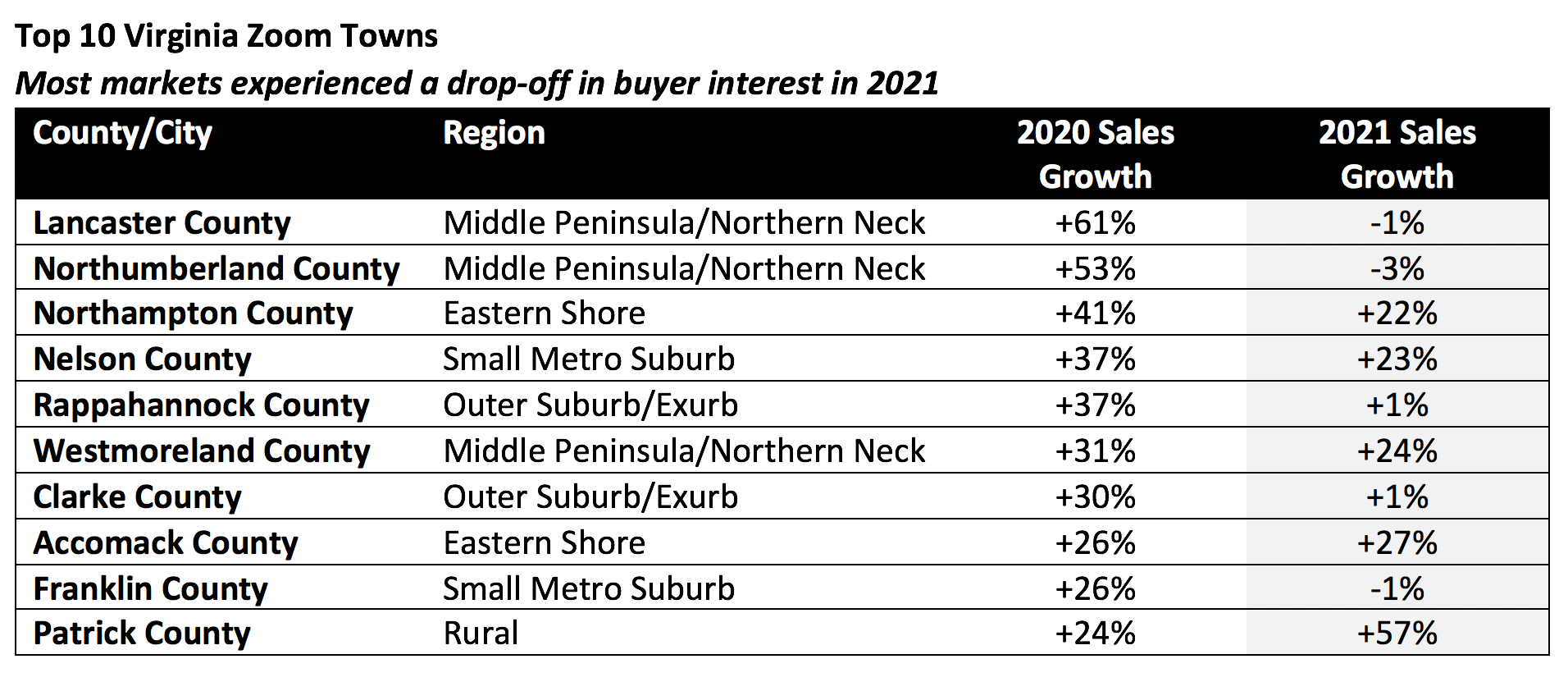Virginia’s Zoom Towns: Boom or Bust After the Pandemic?
November 10, 2021
 “Zoom Towns” are communities where there was an influx of residents as remote work became more popular during the pandemic. Many of these “Zoom Towns” are the same places that have been attracting vacationers and second home residents long before COVID-19. Other places attracted new interest from individuals and families looking to move away from urban areas. Will Virginia’s Zoom Towns continue to boom even after the pandemic ends?
“Zoom Towns” are communities where there was an influx of residents as remote work became more popular during the pandemic. Many of these “Zoom Towns” are the same places that have been attracting vacationers and second home residents long before COVID-19. Other places attracted new interest from individuals and families looking to move away from urban areas. Will Virginia’s Zoom Towns continue to boom even after the pandemic ends?
Working Remotely? Why Not Work Far from the Office?
When the COVID-19 pandemic hit, millions of office workers across the country grabbed their laptops and set up remote work in home offices or at dining room tables. Remote worked surged in 2020. Before the pandemic, only 6% of workers worked from home regularly. In the spring and summer of 2020, nearly 70% of U.S. workers said they were working from home to avoid catching or spreading COVID-19.
While many adults were working from home, children were also learning from home. In the fall of 2020, about 60% of school children nationwide were learning remotely.
The shift to working and learning from home led people to think about how and where they lived. Working remotely meant there was no need to live near the office. Learning remotely meant that living near the physical school building was not important. Quarantining at home made people want more space, both inside and outside the home. Enter the Zoom Town market.
Where Are Virginia’s Zoom Towns?
When people think about Zoom Towns, they often think about people flocking to small towns and rural communities. But the actual pattern in the home-buying market has been a little different. While some small towns and rural communities have attracted remote workers over the past year and a half, most of the Zoom Towns in Virginia are traditional second home or vacation communities with well-known recreational or cultural amenities. Suburban markets at the fringes of the state’s major metro areas have also been big draws for remote workers during the pandemic, indicating that some people wanted to move out, but not too far out.
Buyers were looking for housing in less densely populated communities in 2020, but there is little evidence that home buyers were bolting to the state’s rural communities. Most rural areas in Virginia, which have been experiencing population loss for decades, did not see a big surge in buyer interest during the Zoom Town phenomenon.

Zoom Towns After COVID-19
As vaccination rates rose, COVID cases fell, and people began returning to in-person work and school in 2021, bringing a notable shift in home buyer activity. Some of the Zoom Towns that boomed in 2020 began losing market share to urban and close-in suburban markets.
There were some exceptions. Northampton County and Accomack County on the Eastern Shore have continued to see robust housing demand in 2021, though the pace of sales growth has begun to ease slightly as the second home market slowed. Westmoreland County on the Northern Neck has continued to be a draw for home buyers this year. Nelson County, outside of Charlottesville, and Patrick County, Virginia’s gateway to the Blue Ridge Parkway, have also seen strong home sales activity in 2021.

Zoom Towns and other small, more rural communities in Virginia may begin to see less buyer interest as the COVID-19 pandemic recedes. However, there are ways these areas can position themselves to attract residents who may continue to work remotely or may shift to a hybrid remote/in-person situation.
- Reliable, high-speed interest access is critical to remote workers. There is some evidence that during the pandemic, places with better broadband coverage were more likely to see increased buyer activity. Preliminary analysis of the southwest region of Virginia showed that having access to high-speed internet could increase home values by up to 13%.
- Amenities are important to remote workers. During the pandemic, the most popular Zoom Towns were those with a range of recreational amenities, whether on the water or in the mountains. Arts and cultural amenities will also be a draw for individuals and families looking to move from more urban markets.
- As children head back to in-person learning, the quality of local public school systems will be top of mind for families as they look to make their next move. Investments in K-12 education and high-quality childcare options are important if communities want to attract new families who have the flexibility to live further from their jobs.
For more information on Virginia’s Zoom Towns and the outlook for rural communities across the commonwealth, check out our recent presentation from the 2021 Virginia Governor’s Housing Conference.
Click here to send any comments or questions about this piece to Virginia REALTORS® Chief Economist Lisa Sturtevant, PhD.
You might also like…
See It, Want It, Buy It: Single Female Homeownership
By Dominique Fair - March 11, 2025
Women have fought for a lot over the last 177 years, whether it was for fair wages, the right to vote, or to be able to own a… Read More
Impact of Infrastructure Projects on Residential Markets
By Sejal Naik - February 27, 2025
“Location, location, location” is often quoted in the real estate market and emphasizes the importance of location-based features in people’s housing market decisions. While many locational characteristics stay… Read More
Key Takeaways: January 2025 Virginia Home Sales Report
By Virginia REALTORS® - February 26, 2025
Key Takeaways Virginia’s housing market saw a slight uptick in activity at the beginning of 2025. There were 5,758 home sales across the commonwealth in January 2025, 104… Read More